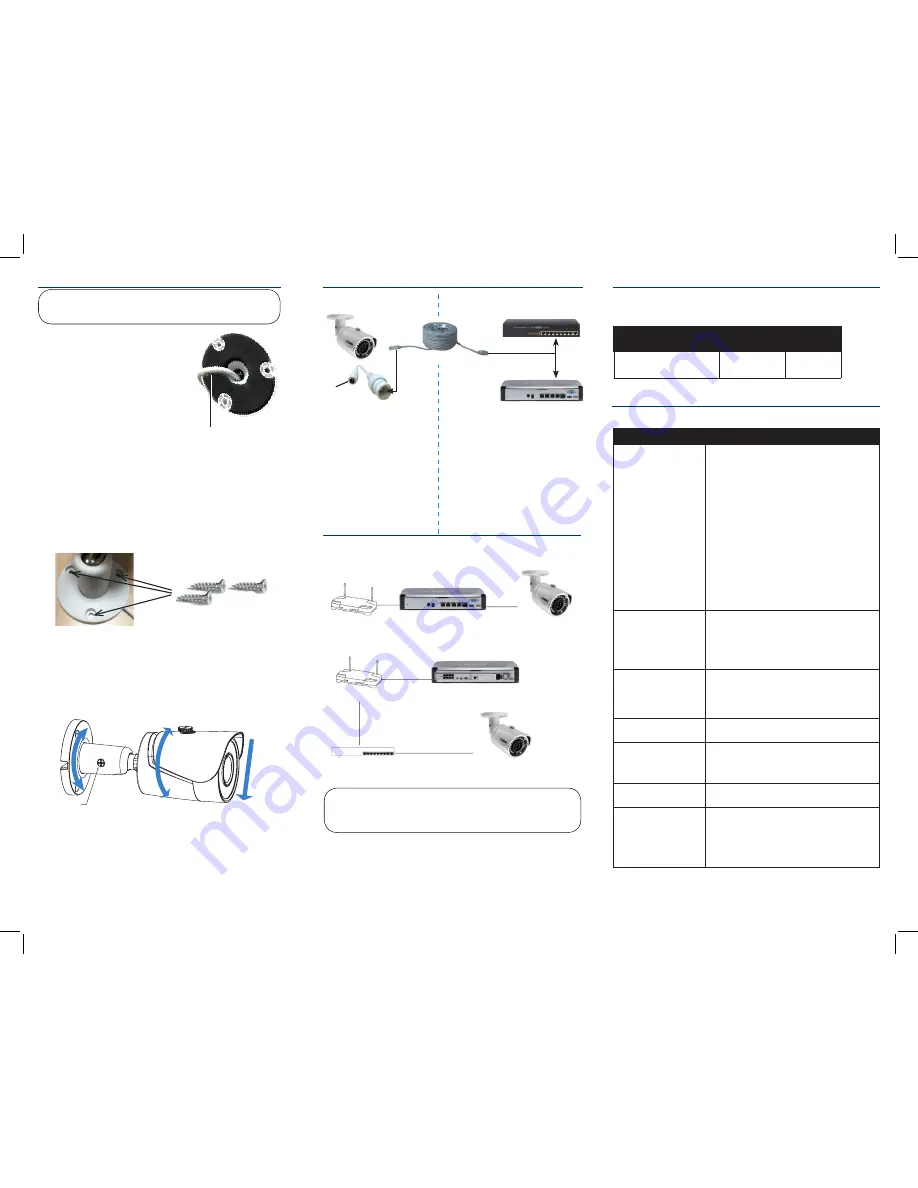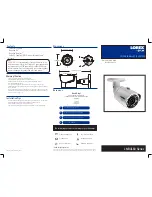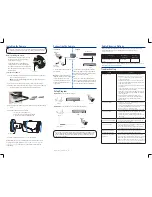
Setup Diagram
Ethernet Cable
12V DC
(optional)
Before installing the camera:
• Decide whether to run the cables through
the wall / ceiling (drilling required) or
along the wall / ceiling.
• If you run the cables along the wall /
ceiling, you must run the cable through
the cable notch on the base. This will keep
the camera base flush to the wall / ceiling
when mounted.
To install the camera:
1. Use the included mounting template to mark holes for the screws. Drill
holes for the mounting screws.
NOTE:
Insert the included drywall anchors if you are installing the
camera in drywall.
2. Connect cables as shown in the section “Connecting the Camera”.
3. Feed the cable through the mounting surface or cable notch and mount
the camera stand to the surface using the provided screws.
Installing the Camera
Cable Extension Options
Extend the Ethernet cable run for your camera up to 300ft. See table below.
It is recommended to use UL CMR approved cables available at
www.
lorextechnology.com
Cable Type
Max Cable Run
Distance
Max # of
Extensions
Cat5e or higher Ethernet
cable
300ft / 92m
3
You can use a RJ45 Coupler (not included) or switch (not included) to connect
male ends of Ethernet cable together.
ATTENTION
- Ensure the camera is working correctly prior to permanent
installation by temporarily connecting the camera(s) and cable(s) to the
NVR.
Problem
Solution
No picture / signal
• Ensure the camera is connected to a compatible
NVR. Visit
https://www.lorextechnology.com/support/
selfServe.jsp,
and search for “Lorex High Definition
Cameras Compatibility”.
• The camera may take up to 1 minute to power up after
being connected to the NVR. Wait two minutes before
following the steps below
• Ensure the camera is connected to your NVR or to your
local network
• If you are not using PoE, you must connect the camera to
a 12V DC power adapter (not included)
• If the camera is connected to the LAN, you must search
your network for cameras using the NVR. See the NVR’s
Instruction Manual
• Ensure your NVR is connected to a TV/monitor
• There may be an issue with your extension cable run.
Connect the camera to the NVR using a different
Ethernet cable
Picture is too bright
• Ensure your camera isn’t pointed directly at a source of
light (e.g. sun or spot light)
• Slide the sunshade (bullet cameras featuring adjustable
sunshades only) forward to block excess light
• Move your camera to a different location
• Check the brightness and contrast settings on the NVR
Picture is too dark
• If using during the day, the camera may not be getting
enough light. Slide the sunshade (bullet cameras
featuring adjustable sunshades only) backwards to let
in more light
• Check the brightness and contrast settings on the NVR
Night vision is not working
• The night vision activates when light levels drop. The
area may have too much light
Picture is not clear
• Check the camera lens for dirt, dust, spiderwebs. Clean
the lens with a soft, clean cloth
• Make sure that the cable run is within the limitations
specified in the section ‘Cable Extension Options’
Bright spot in video when
viewing camera at night
• Night vision reflects when pointing a camera at a
window. Move the camera to a different location
Picture is in color in dark
conditions
This camera comes with an image sensor that is extra
sensitive to light, meaning that the camera stays in color
mode at low-light conditions. For instructions on how to
make your camera switch to night mode, visit
https://www.
lorextechnology.com/support/selfServe.jsp
, and search for
“How do I make my camera switch to night mode?”
Troubleshooting
To Camera:
To NVR:
1. Connect the Ethernet cable to
the camera.
NOTE:
A 12V DC power adapter
(Model#: CVA4902, not included)
is only required if connecting
the camera’s Ethernet cable to
a router or switch that does not
support PoE.
2. Connect the other end of the Ethernet
cable to the NVR’s PoE ports. The camera
may take up to 1 minute to power up after
being connected to the NVR.
OR
Connect the other end of the Ethernet
cable to a router or switch on your network.
See the NVR Instruction Manual for details
on connecting the camera to your NVR.
Connecting the Camera
Cable Notch
4. Use a Philips head screwdriver (not included) to loosen the adjustment
screw.
5. Adjust the camera position as needed:
6. Tighten the adjustment screw to secure the position.
1. Rotate the camera base 360°.
2. Twist the camera around the stand 360°.
3. Tilt the camera on the stand up to 90°.
NVR
ATTENTION
- This camera includes an Auto Mechanical IR Cut Filter. When the
camera changes between Day/Night viewing modes, an audible clicking noise
may be heard from the camera. This clicking is normal, and indicates that the
camera filter is working.
OR
Router or switch
Adjustment screw
SCENARIO 1:
Connect Cameras to NVR
SCENARIO 2:
Connect Cameras to Local Area Network (LAN)
Router
Router
NVR
NVR
Camera
Camera
PoE Switch
LNB3163_SERIES_TRIFOLDQSG_EN_R2
ATTENTION
- This camera is only compatible with select NVRs. For a list
of compatible recorders, please visit
https://www.lorextechnology.com/
support/selfServe.jsp,
and search for “Lorex High Definition Cameras
Compatibility”.




















